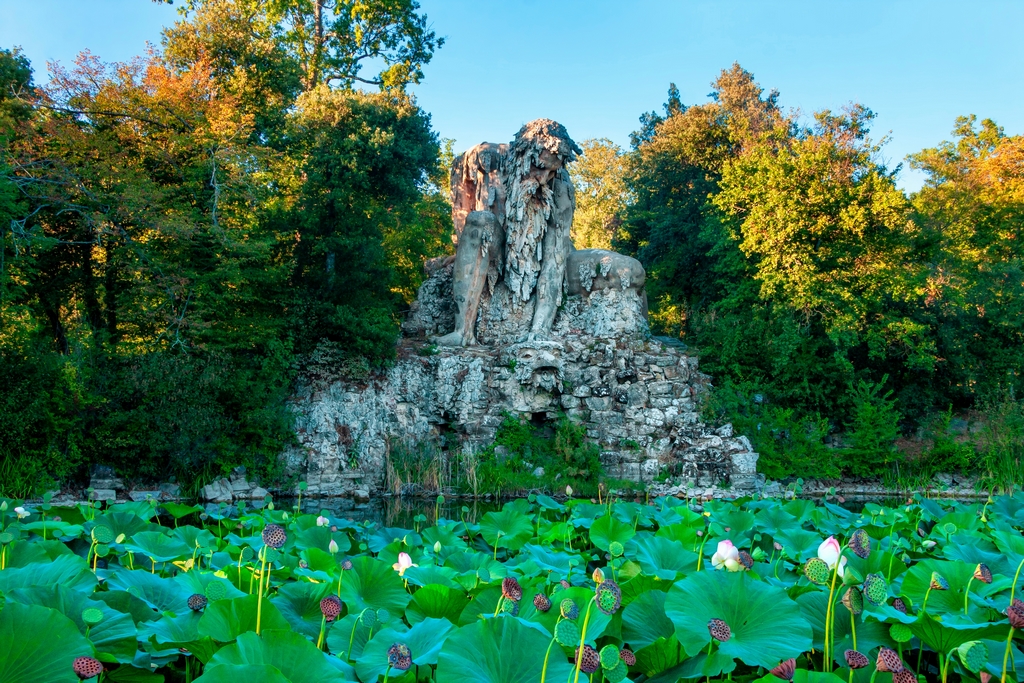Guarding Mountain Waters


Located in the heart of Tuscany, the Colossus of the Apennines stands guard over the surrounding historic landscape like an ancient sentinel. Not only an imposing sculpture, the massive statue was also a remarkable example of early watershaping innovation.
By Chester A. Arthur
He looms over the water like a mythical god turned to stone. The Colossus of the Apennines is truly awe-inspiring. Made entirely of stone and plaster, the massive sculpture is 11 meters tall, casting an imposing image and reflection over the historic, surrounding landscape.
It was built between 1579 and 1580 by the Flemish artist Jean de Boulogne, known as Giambologna, as a symbol of the mountains of the Apennines in Italy. Today the colossus is a main attraction at Villa Demidoff, the modern remains of the Villa Medici in Pratolino.
Named a UNESCO World Heritage Site in 2013, today it is one of the largest parks in Tuscany. Although many of its artifacts and features have been lost to time and plunder, the Colossus of the Apennines remains, rising majestically over the water in the heart of the lush garden.
MAJESTIC INGENUITY
Originally, the feature functioned as the primary water source for the Pratolino. Purely an artistic statement these days, the colossus wears the guise of an elderly man crouched at the shore of a lake. Although frozen in time, the image depicts power, motion and domination. With his left hand in front of him, he seems to squeeze the head of a sea monster through whose open mouth water flows into the pond.
It’s a violent image depicting man’s hegemony over nature. The stone colossus is depicted naked, his long, thick beard and Medusa-like hair represent the metamorphosis of man and earth into one, as his body fuses into the lush surrounding landscape.
He is surrounded by other sculptures depicting mythological themes including Pegasus, Parnassus and Jupiter. Historians believe Giambologna was inspired by the description of a mountain-like Atlas in Ovid’s Metamorphoses, while others cite the Atlas as described in the Aeneid of the Roman poet Virgil as an inspiration.
The statue is described to originally have been emerging from its environment as if alive, an illusion sculpted by water – able to sweat and weep via a network of water pipes.
In the winter icicles would cover his body. In warmer seasons, he would be partially covered with moss and lichens.
GRANDEUR LOST
The Villa di Pratolino in Florence was built in the 1570s by Francesco de Medici, the Grand Duke of Tuscany. He is thought to have built the villa for his famed Venetian mistress, Bianca Cappello, as a wedding present.
The lavish property was considered a pristine example of a Mannerist garden. In the late Renaissance period, Mannerism art sought to express exaggerated, sophisticated elegance. As symbols of wealth and fashion, Mannerist gardens were novel and dramatic, with opulent water features driven by gravity and hydraulics.
In a very real sense, the site is an early example of watershaping on a highly creative level. When French philosopher Montaigne visited the vast gardens in 1580, which at the time were still unfinished, he was awestruck by the complex array of water-powered displays. Montaigne described water jets leaping over paths and staircases, and water displays that played music and brought animal figures to life.
After the Duke died, the villa soon fell into ruin, and many of the sculptures were destroyed, stolen or relocated to other gardens. The Colossus, the most stunning marvel of the villa remains, most likely due simply to the fact that it too big to move.
HIDDEN LUXURY
Inside the statue, a once-secret compartment is situated in the upper part of the body and in the head. In fact, research has revealed the statue contains a number of rooms with frescoes and fountains that were once powered by ingenious hydraulic mechanisms.
There is also a “fireplace” that would blow smoke out of the giant’s nostrils and light up its eyes. He could also sweat and cry via intricate plumbing details. On the ground floor, a grotto features with an octagonal fountain dedicated to Thetys, the mother of river gods in Greek mythology. Ornate mosaics depicting mines and coastal villages appear throughout the complex of caves and chambers.
Today, the caves are open to visitors and are easily accessed via a staircase behind the statue.
Nearly five centuries old, Colossus of Apennines appears poised for the long journey into the future. From now until then, the he will continue to inspire awe.
Chester A. Burnett is a Los Angeles-based writer, world traveler, master machinist, motorcycle enthusiast and blues harmonica player. He is quick to point out that his intelligence is not artificial.
Opening image by Vlas Telino Studio | Shutterstock










